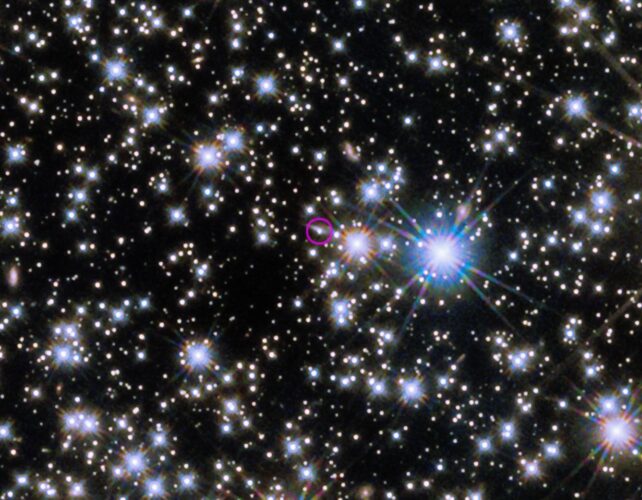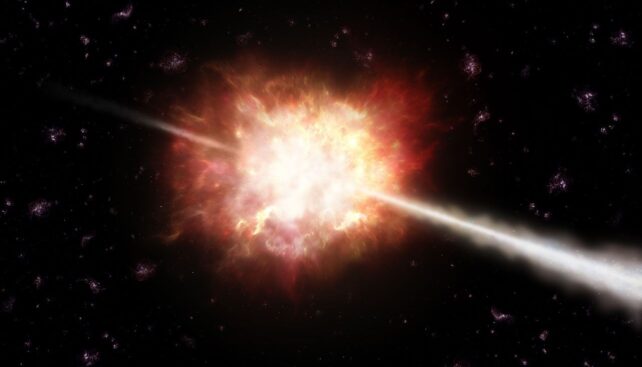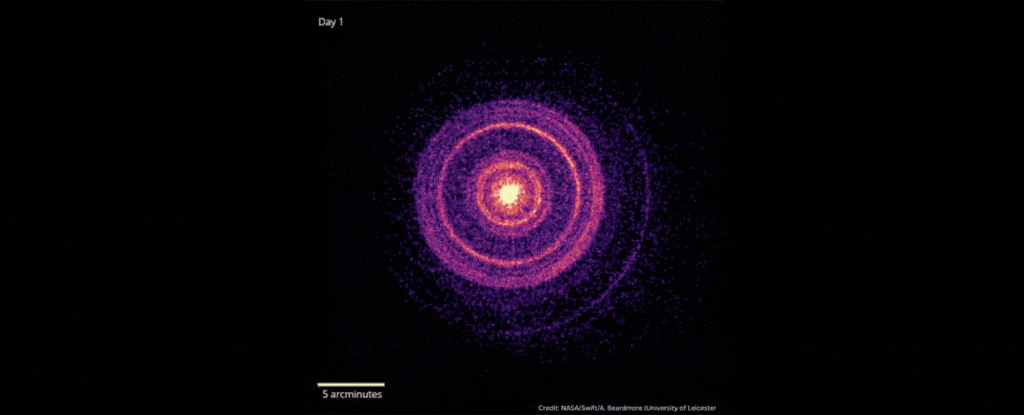A record-breaking space explosion that lit up the sky with the most power we've ever seen was caused by a structured jet carrying massive amounts of exploded star guts pointing directly at Earth, scientists have determined.
The gamma-ray burst GRB 221009A, detected in October of last year, was so bright that our instruments struggled to measure it. But when the first hints of it came through, scientists scrambled to point telescopes in its direction, and with the wealth of data collected, an international team of scientists has finally figured out how the supernova generated such a powerful kaboom.
GRB 221009A, nicknamed the BOAT (for Brightest of All Time), was the result of the death of a massive star a relatively close 2.4 billion light-years away, collapsing down into a black hole after expelling its outer envelope. The gamma-ray burst produced by this collapse contained a narrow, structured jet surrounded by a wider outflow of gas.
This is unexpected; our current models predict that the explosion would produce just a jet. The findings have implications for our understanding of the formation of black holes, and how the brightest explosions in the Universe take place.

"GRB 221009A represents a massive step forward in our understanding of gamma-ray bursts, and demonstrates that the most extreme explosions do not obey the standard physics assumed for garden variety gamma-ray bursts," says astronomer Brendan O'Connor of George Washington University, lead author on the new paper.
"GRB 221009A might be the equivalent Rosetta stone of long GRBs, forcing us to revise our standard theories of how relativistic outflows are formed in collapsing massive stars."
Gamma-ray bursts are the most powerful explosions seen across the cosmos, and they occur in a number of ways. Long-duration gamma-ray bursts, like GRB 221009A, are caused by the deaths of massive, rapidly rotating stars.
When they reach the end of their lives, the cores of these stars, no longer supported by the outward pressure of fusion, collapse under gravity to form an ultradense object, such as a black hole. Concurrently, the outer star material is ejected outward in a huge explosion, the supernova.
It wasn't immediately apparent what we were looking at with GRB 221009A, although its long duration suggested a supernova. But the sheer power of the blast – up to 18 teraelectronvolts, a jaw-dropping record – was genuinely puzzling, and the puzzle only deepened as scientists continued to dig.
We know that gamma-ray bursts are accompanied by jets, twin columns of material emerging from opposite sides of a collapsing object, carrying material at relativistic velocities; that is, a significant percentage of the speed of light. We also know that these jets appear brighter when they're pointed at us directly; think of staring directly down the beam of a flashlight, as opposed to at an angle.
Scientists had already come to the conclusion that the jet of GRB 221009A was pointed at Earth, but the afterglow of the explosion was still brilliant months later. This is not characteristic of a narrow jet of emission, suggesting that something else was going on.
That something else, the team's analysis suggests, was a large amount of ejected outer star material being dragged along by the jet as it punched through.

"GRB jets need to go through the collapsing star in which they are formed," explains astrophysicist Hendrik Van Eerten of the University of Bath in the UK.
"What we think made the difference in this case was the amount of mixing that happened between the stellar material and the jet, such that shock-heated gas kept appearing in our line of sight all the way up to the point that any characteristic jet signature would have been lost in the overall emission from the afterglow."
The findings could help explain previous exceptionally bright gamma-ray bursts that also did not exhibit the typical jet signature. These explosions could also consist of a narrow jet pointed in our direction, punching through and dragging the guts of exploded stars along with them.
"The exceptionally long GRB 221009A is the brightest GRB ever recorded and its afterglow is smashing all records at all wavelengths," O'Connor says.
"Because this burst is so bright and also nearby, we think this is a once-in-a-thousand-year opportunity to address some of the most fundamental questions regarding these explosions, from the formation of black holes to tests of dark matter models."
The research has been published in Science Advances.
